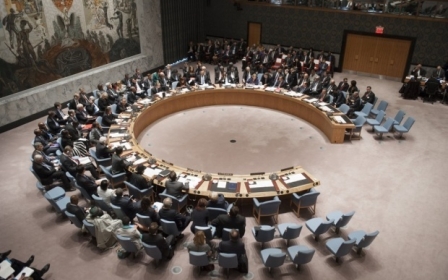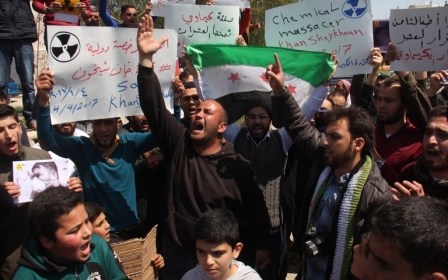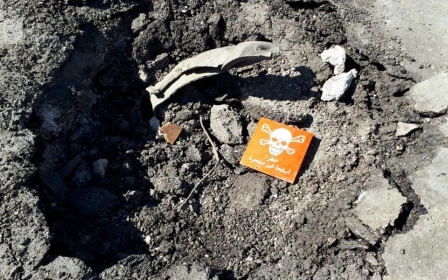Syria's chemical weapons: Investigation needs full access and must happen fast

The UN Security Council will today vote on a resolution to investigate the chemical attack in the northwestern Syrian town of Khan Sheikhun last week, which killed up to 100 and injured hundreds more.
The Syrian regime acceded to the Chemical Weapons Convention (CWC) in 2013 after the massive Sarin nerve agent attack on 21 August of that year in the Damascus suburb of Ghouta which killed 1,500 people. The CWC is policed by the Organisation for the Prohibition of Chemical Weapons (OPCW). As a member of the CWC, the Syrian regime is obliged to declare and destroy all chemical weapons and allow unfettered access to all chemical sites if the UN Security Council so directs.
Many experts, myself included, believed - and still believe - that there was up to 200 tonnes of Sarin and its precursors missing from Syria's declared stockpile
Up until now, the OPCW has had mixed results when investigating chemical attacks in Syria. After the massive Ghouta attack, the OPCW investigation led to the removal and destruction of the declared Syrian chemical weapons stockpile and rightly earned it the Nobel Peace Prize.
One of the challenges of the CWC is that, if accused of chemical usage, the accused member nation is required to invite the OPCW to investigate. The member nation is then required to show and declare to the OPCW all sites and stocks of these weapons. The OPCW will then organise the removal and destruction of chemical agents and the ability to make new agents.
Missing 200 tonnes
What is now clear from last week’s attack is that the Assad regime did not declare all its chemical weapon stocks. In 2013, the Syrian regime declared 1,300 tonnes of agents and precursor chemicals. Many had expected a declaration of around 1,500 tonnes, and many experts, including myself, believed - and still believe - that there was up to 200 tonnes of Sarin and its precursors missing.
The likely explanation for this admission is simple: the regime hid these agents from the OPCW and/or some of these weapons were in areas that the OPCW couldn’t get to because of the civil war.
The second challenge since 2013 for the OPCW in Syria - where there have been 170 alleged chemical attacks since the UN Security Council outlawed chemical weapons in the country in September of that year - is the time taken to investigate these attacks. There was a chlorine attack on Kafr Zita in Idlib on 18 April 2014, which I investigated with the Union of Medical Care and Relief Organisations (UOSSM), a coalition of humanitarian, non-governmental and medical organisations.
Timing is crucial and unless the investigation team get into Syria very soon, evidence will be contaminated, removed or changed
Our people collected samples from the site and we tested the samples declaring that they contained chlorine on 29 April 14. It then took the UN more than nine months to confirm these results. We, of course, are not an official body and hence the UN could not act on our results.
Three ways to improve
If the UN security council sanctions these inspections today, and Russia does not veto them, they will need to be more comprehensive and timely than they have been up until now. Though this seems an insurmountable task, I believe there are ways that the UN can enable the OPCW to do this.
Firstly, UN peacekeepers could support the OPCW to enable them unfettered access across Syria, including areas held by rebels. The CWC was not set up with the expectation that inspectors would have to investigate attacks during a civil war, and Syria has shown that this is now the most likely environment that the OPCW is likely to have to operate within in future. If the OPCW cannot visit an attack site, for instance in Idlib, the credibility of their findings will be marginalised.
Secondly, the OPCW should be allowed to collect all information and evidence, not just what the Syrian regime will allow. UOSSM and other NGOs in Syria have collected a lot of evidence and this should be admissible to the investigation. Some of this evidence has already made its way into Turkey, and the Turkish Medical Ministry declared on Tuesday that these samples tested positive for Sarin.
Thirdly, timing is crucial and unless the investigation team get into Syria very soon, evidence will be contaminated, removed or changed.
Reimposing the red line
It is very clear to me that the Syrian regime are responsible for the Sarin nerve agents attack on Khan Sheikhun last week. The most likely scenario is that Syrian aircraft dropped a number of bombs filled with the deadly agent which caused the casualties.
As hopeless as it seems at the moment, I still hold that the UN and OPCW can to do a timely and successful investigation of the latest attacks
Conspiracy theories that these jets targeted al-Nusra ammunition dumps that were full of Sarin are fanciful, and the Russian government has recently distanced itself from this idea. Axiomatically, if you blow up Sarin you destroy it, hence the Syrian jets could have attacked an ammunition dump, but they would have destroyed any Sarin there, and not created hundreds of chemical casualties.
As hopeless as it seems at the moment, I still hold that the UN and OPCW can to do a timely and successful investigation of the latest attacks. But they must be supported by UN troops to allow them access across all parts of Syria, they must be allowed to take all evidence into consideration, even that which has been collected not under direct OPCW rules for chain of evidence procedures, and we must get on with it as soon as possible.
Despite these challenges, the US strikes destroying the Syrian aircraft which delivered the Sarin which killed so many last week has, at the very least, effectively re-imposed the so called "red line" on the use of chemical weapons and restored the taboo of chemical weapon usage which had held since the First World War.
- Hamish de Bretton-Gordon is a director of Doctors Under Fire and an adviser to the Union of Medical Care and Relief Organisations. A former soldier, he was commanding officer of the UK Chemical, Biological, Radiological and Nuclear (CBRN) Regiment and Nato’s Rapid Reaction CBRN Battalion.
The views expressed in this article belong to the author and do not necessarily reflect the editorial policy of Middle East Eye.
Photo: Weeks after the Ghouta attack, volunteers wear gas masks during a class on how to respond to a chemical attack, in the northern Syrian city of Aleppo on 15 September 2013 (AFP)
New MEE newsletter: Jerusalem Dispatch
Sign up to get the latest insights and analysis on Israel-Palestine, alongside Turkey Unpacked and other MEE newsletters
Middle East Eye delivers independent and unrivalled coverage and analysis of the Middle East, North Africa and beyond. To learn more about republishing this content and the associated fees, please fill out this form. More about MEE can be found here.





